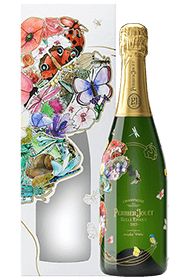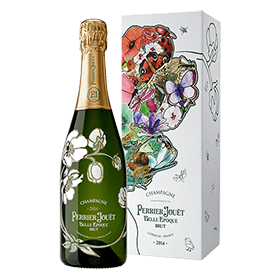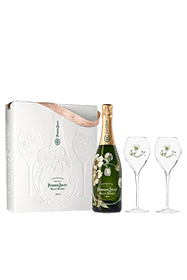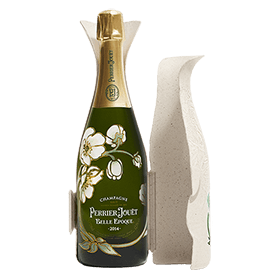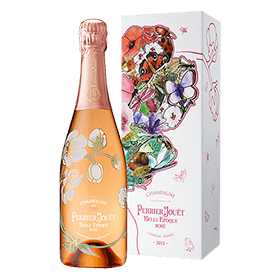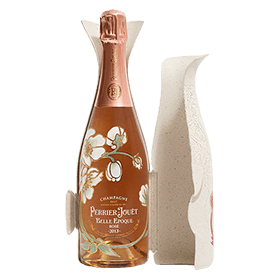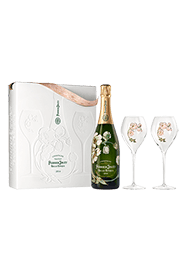Founded in 1811 by the union of two enthusiasts, Maison de Champagne Perrier-Jouët has, for over two centuries, crafted cuvées that combine finesse, aromatic richness, and the pure expression of the great Champagne terroirs.
Perrier-Jouët, Champagne elegance
Since 1811, Maison Perrier-Jouët has embodied a unique vision of champagne, where the delicacy of Chardonnay meets the refined aesthetics of Art Nouveau. Born from the union of Pierre Nicolas Perrier and Rose Adélaïde Jouët, this emblematic Épernay house has established itself as a benchmark among prestige champagnes, supplying Europe’s royal courts. Located in the heart of Champagne, the estate has cultivated for over two centuries an approach focused on the pure expression of Chardonnay from the region’s finest terroirs.
Champagne expression according to Perrier-Jouët
Chardonnay as an emblem
The House’s cuvées stand out for a strong predominance of Chardonnay, which occupies nearly 40 of the 65 hectares of the vineyard, imparting finesse, elegance, and tension. On the palate, this dominance reveals delicate aromas of white flowers, citrus, and white-fleshed fruit, supported by a finely chiseled, precise freshness.
Grand Brut, a champagne imbued with harmony
A non-vintage blend in which Chardonnay also plays a leading role, this champagne offers a more accessible expression while retaining the floral and mineral signature of the estate. Served between 8 and 10°C, it pairs beautifully with seafood, grilled fish, and soft cheeses. Its balance between freshness and roundness makes it a versatile champagne, as relevant as an aperitif as it is throughout a meal.
Belle Époque, the floral icon
The Belle Époque cuvée embodies the most accomplished expression of this philosophy. Its bottle, adorned with the famous Japanese anemones drawn by Émile Gallé in 1902, holds a vintage cuvée of great aromatic complexity. On the nose, it offers notes of white flowers, white peach, and fresh hazelnut. On the palate, the attack is both lively and creamy, sustained by a fine, persistent mousse, extending into a beautiful finish and offering great aging potential.
Also available as a rosé, the Belle Époque Rosé cuvée elegantly marries delicate floral notes with delectable red fruit aromas.
Blanc de Blancs: bottles revealing the beauty of Chardonnay
Blanc de Blancs brilliantly illustrates Maison Perrier-Jouët’s expertise in crafting Chardonnay-based champagnes. Available as Perrier-Jouët Blanc de Blancs and the exceptional vintage “Belle Époque Blanc de Blancs,” it seduces with finesse and elegance. Its bouquet unveils refined floral notes, while the palate is brightened by citrus freshness subtly lifted by a touch of honey. This champagne vividly expresses the purity and uniqueness of Chardonnay from the Côte des Blancs.
Perrier-Jouët Rosé, the art of blending
Perrier-Jouët Rosé celebrates the full richness of Pinot Noir through a flavor palette as gourmet as it is complex, where red fruits, citrus, and floral notes harmoniously intertwine. On the palate, its remarkable freshness is accompanied by fine structure and a long, elegant finish. Offered in the “Blason Rosé” and “Belle Époque Rosé” cuvées, this alluring champagne gracefully accompanies all your tasting moments.
Constant international recognition
As early as 1861, the House gained international renown thanks to recognition from Queen Victoria and the enthusiasm of Europe’s great courts. Founded in 1811 by Pierre Nicolas Perrier and Rose Adélaïde Jouët, it has spanned eras, asserting itself through the excellence of its cuvées. The arrival of the Gallice brothers infused a unique artistic dimension, crystallized by collaboration with Émile Gallé, an emblematic figure of Art Nouveau, who in 1902 created the famous floral motif of Belle Époque.
Now part of the Pernod Ricard group through its subsidiary Martell Mumm Perrier-Jouët, the House combines modernity and tradition, preserving its unique identity and historical savoir-faire.
An exceptional heritage and traditional know-how
The vineyard, established from 1860, extends over 65 hectares exclusively in Grands Crus, mainly in Cramant and Avize for Chardonnay, and in Aÿ and Mailly-Champagne for Pinot Noir. This “golden triangle” ensures access to the best grapes. The chalky Campanian soils provide drainage, minerality, and freshness, while the chalk favors harmonious maturation. The semi-continental climate, combined with vines averaging 23 years old, allows for a faithful and complex expression of the terroir.
Winemaking follows traditional Champagne methods, prioritizing freshness and aromatic finesse. Extended lees aging, far longer than the standards, develops complexity while preserving the wines’ tension, a key factor in their longevity.




